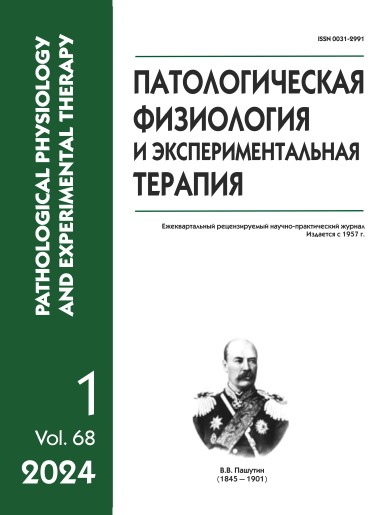Neutrophil extracellular traps in inflammatory diseases of the abdominal cavity
DOI:
https://doi.org/10.25557/0031-2991.2024.01.15-25Keywords:
morphological structure of neutrophil extracellular traps, NETs, inflammation, functional activity of NETsAbstract
The development of infectious complications in patients with inflammatory diseases is determined by how effective protective reaction the patient's neutrophils will develop upon contact with the pathogen. The body's anti-infective resistance is largely determined by the willingness of neutrophils to form neutrophilic networks capable of effectively capturing pathogens. Aim. Determination of parameters of neutrophil extracellular traps (NETs) in patients with inflammatory diseases of the abdominal cavity. Patients and methods. 28 operated patients with various forms of abdominal inflammation and 6 therapeutic patients with ulcerative colitis were examined, 6 patients were examined upon admission. Neutrophils were isolated using gradient centrifugation. To calculate the NETs, fluorescence microscopy with the dye SYBR Green (Evrogen; Russia), which specifically interacts with double-stranded DNA, was used. The functional activity of NETs was determined in the Klebsiella pneumoniae capture test (ATCC 700603). Results. In the study of patients in the postoperative period, it was found that in acute appendicitis/abscess, acute cholecystitis and acute pancreatitis/pancreonecrosis, similar amounts of NETs are found - 12,63±2,13%, 15,66±2,81% and 12.64±2.73%. In the same groups of patients, significant differences in the size of the NETs are recorded, which reach 46.82±6.70 microns, 73.62±16.29 microns and 96.84±27.17 microns, respectively. The increase in the size of the NETs in these groups of patients is explained by the presence, in addition to network-like structures, additionally filamentous, fibrous and cloud-like neutrophil extracellular structures. A group of patients with nonspecific ulcerative colitis receiving conservative treatment (comparison group) shows a tendency to decrease the size of the NEL to a value of 31.96±14.75 microns. A study of the functional activity of NETs shows that its decrease precedes the development of a septic condition (using the example of an identified clinical case). Conclusion. All, without exception, the studied nosological forms of inflammation in the abdominal cavity are accompanied by the formation of NETs in the form of neutrophilic networks. In addition to neutrophilic networks, inflammation induces the formation of NETs in the form of single strands, fibers and clouds form in some patients. The quantitative parameters of the NETs correlate with the size and spread of the inflammatory focus to neighboring anatomical areas. On the example of the described clinical case, a sharp decrease in the functional activity of NETs was found, which preceded the development of a septic complication. There is a connection between the initially weakened functional activity of NETs and the development of septic complications in the patient in the postoperative period.Downloads
Published
2024-03-28
Issue
Section
Original research
How to Cite
[1]
2024. Neutrophil extracellular traps in inflammatory diseases of the abdominal cavity. Patologicheskaya Fiziologiya i Eksperimental’naya Terapiya (Pathological physiology and experimental therapy). 68, 1 (Mar. 2024), 15–25. DOI:https://doi.org/10.25557/0031-2991.2024.01.15-25.






